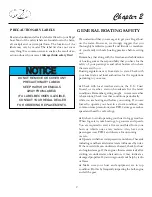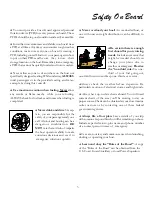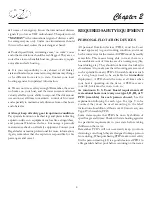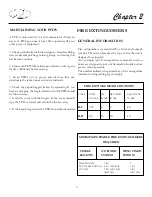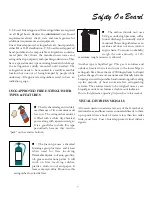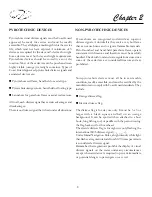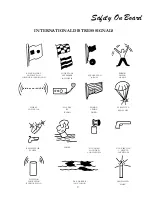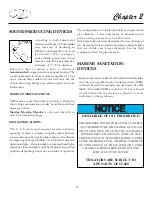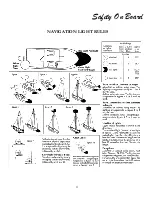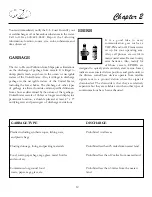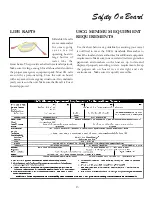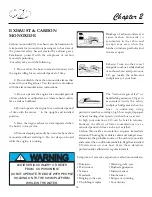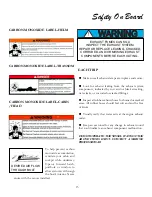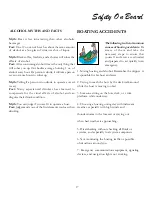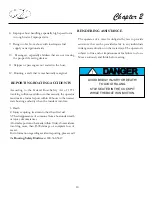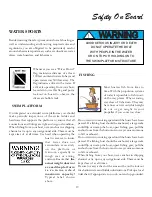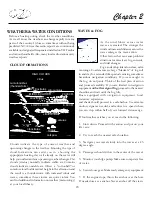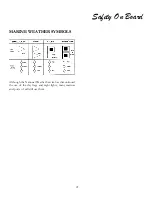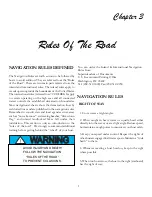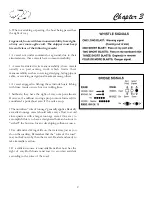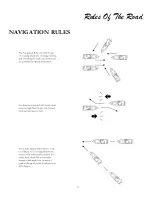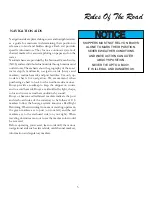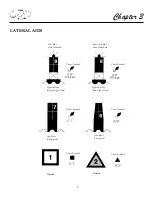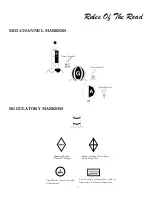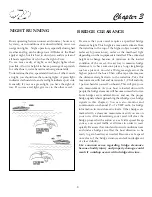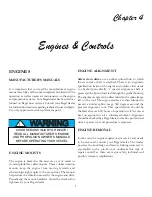
16
Chapter 2
At Least Annually
(To be performed by a marine
professional);
5
Replace exhaust hoses or mufflers if any evidence of
cracking, charring or deterioration is found.
5
Replace the engine water pump impeller along with
the plate and housing if necessary. This will help prevent
cooling system and in turn exhaust system overheating.
5
Inspect each of the metallic exhaust components for
cracking, rusting, leaking or looseness. Pay detailed
atttention to the exhaust manifold, cylinder head, water
injection elbows.
BOATING & ALCOHOL
Operating a vessel while intoxicated became a specific
federal offense effective in 1988. The ruling set federal
standards for determining when an individual is
intoxicated. If the blood alcohol content (BAC) is .10%
(.08 in some states) or higher for operators of recreational
vessels being used only for pleasure are subject to a civil
penalty up to $1,000 or criminal penalty up to $5,000, one
year imprisonment or both. In some states the fines and
imprisonment may increase significantly.
The effects of alcohol and drugs account for the highest
single cause of marine accidents and deaths. Most deaths
in boating accidents occur when someone falls into the
water. Balance is one of the first things you lose when
drinking alcohol or under the influence of drugs. The
problem arises out of not knowing your balance is
restricted.
Overall vision is reduced by alcohol especially at night,
along with double or blurred vision. Peripheral vision is
lessened which restricts seeing vessels or objects on the
side. Also, color awareness decreases especially with red
and green which happen to be the colors of boat
navigation lights, buoys, and channel markers.
Alcohol will greatly increase your heat loss so it increases
the effects of hypothermia. Finally, your ability to make
correct judgements in emergency situations is greatly
reduced. Alcohol takes away the brains ability to process
information quickly and delays a persons reaction time.
Don’t drink and drive!
FEDERAL LAWS PROHIBIT OPERATING
A VESSEL UNDER THE INFLUENCE OF
ALCOHOL OR DRUGS.
THESE LAWS ARE VIGOROUSLY
ENFORCED BY ALL LOCAL, STATE AND
FEDERAL AGENCIES.
WARNING
!
Summary of Contents for 30 EXPRESS
Page 1: ...30 EXPRESS OWNER S MANUAL...
Page 2: ...784022 OWNER S MANUAL 30 EXPRESS 12 2012...
Page 30: ...11 Safety On Board NAVIGATION LIGHT RULES...
Page 41: ...Chapter 2 22 Notes...
Page 44: ...3 Rules Of The Road NAVIGATION RULES...
Page 85: ...28 Chapter 5 Notes...
Page 105: ...4 Chapter 7...
Page 106: ...5 Equipment Operation...
Page 107: ...6 Chapter 7...
Page 108: ...7 Equipment Operation...
Page 109: ...8 Chapter 7...
Page 110: ...9 Equipment Operation...
Page 111: ...10 Chapter 7...
Page 117: ...16 Chapter 7...
Page 126: ...25 Equipment Operation ROTARY ENCODER AND MENU KEY...
Page 127: ...26 Chapter 7 USING THE ROTARY ENCODER AND MENU KEY...
Page 158: ...57 Equipment Operation BACKING A TRAILER 1 2 3 4 LAUNCHING RAMP...
Page 161: ...60 Chapter 7 Notes...
Page 195: ...34 Chapter 8 Notes...
Page 204: ...9 Troubleshooting TOILET SYSTEM DIAGNOSTIC CHART...
Page 209: ...14 Chapter 9...
Page 219: ...6 Chapter 11 Notes...
Page 221: ...2 Chapter 12...
Page 224: ...5 Technical Information 30 Express Deck Overview 30 Express Cabin Overview...
Page 225: ...Technical Information 12 6 30 EXPRESS...
Page 226: ...12 7 Technical Information 30 EXPRESS...
Page 227: ...Technical Information 12 8 30 EXPRESS...
Page 228: ...12 9 Technical Information 30 EXPRESS...
Page 229: ...Technical Information 12 10 30 EXPRESS 30 EXPRESS...
Page 230: ...12 11 Technical Information TYPICAL NEGATIVE GROUND SYSTEM...
Page 231: ...Technical Information 12 12 30 EXPRESS...
Page 232: ...12 13 Technical Information 30 EXPRESS...

